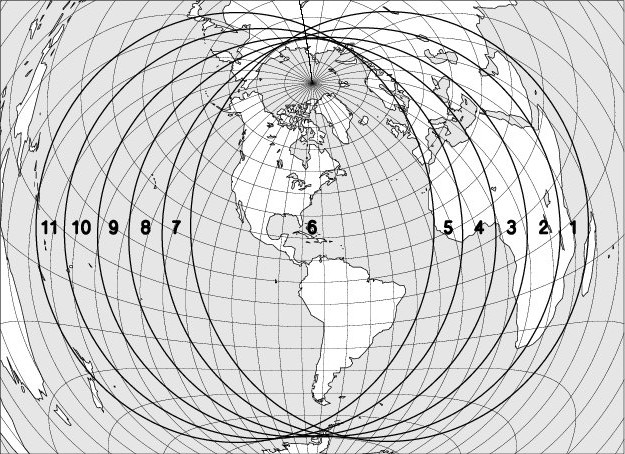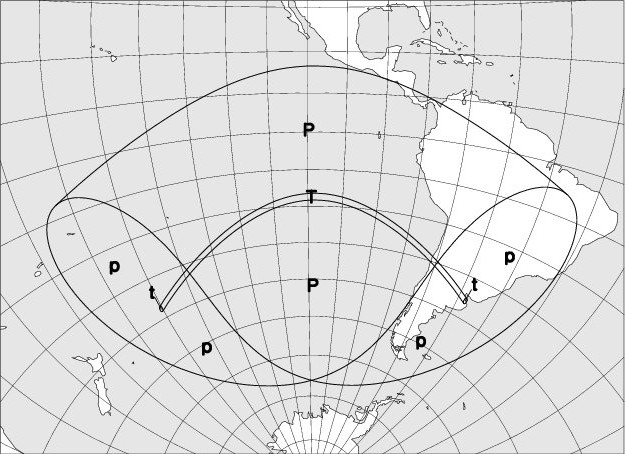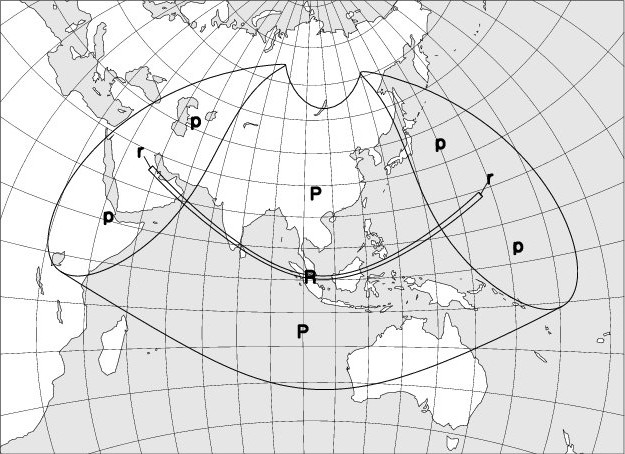In 2019, there will be five eclipses: three solar eclipses and two lunar eclipses
| Date | Type | Visibility |
| 5 – 6 January 2019 | Partial solar eclipse | Invisible in Belgium |
| 21 January 2019 | Total lunar eclipse | Partially visible in Belgium |
| 2 July 2019 | Total solar eclipse | Not visible in Belgium |
| 16 – 17 July 2019 | Partial lunar eclipse | Partially visible in Belgium |
| 26 December 2019 | Annular solar eclipse | Not visible in Belgium |
I – 5/6 January 2019 – Partial solar eclipse, not visible in Belgium
| Phase | Universal time | Longitude | Latitude |
| Beginning of the eclipse | 5 January 2019 23:34.1 | 119 04 E | 41 36 N |
| Maximum of the eclipse | 6 January 2019 01:41.4 | 153 35 E | 67 19 N |
| End of the eclipse | 6 January 2019 03:48.8 | 168 19 W | 43 13 N |
Magnitude of the eclipse: 0.715, the diameter of the solar disk being taken as the unit.
The map below shows the region where the eclipse is observable. The explanation of the codes used can be found at the bottom of the page.

II – 21 January 2019 – Total lunar eclipse, partially visible in Belgium
| Phase | Universal Time |
Longitude | Latitude | Position angle | Altitude at Uccle/Ukkel |
| Penumbral eclipse begins | 02:35.0 | 037 34 W | 20 32 N | 110 E | +45 |
| The Moon enters the shadow | 03:33.5 | 051 35 W | 20 28 N | 118 E | +36 |
| Full eclipse begins | 04:40.8 | 067 41 W | 20 23 N | 147 E | +26 |
| Maximum of the eclipse | 05:12.3 | 075 14 W | 20 20 N | 187 E | +21 |
| Full eclipse ends | 05:43.8 | 082 47 W | 20 18 N | 226 E | +16 |
| The Moon comes out of the shadow | 06:51.0 | 098 53 W | 20 12 N | 256 E | +07 |
| Moonset at Uccle/Ukkel | 07:39.3 | 110 27 W | 20 08 N | 262 E | 0 |
| Penumbral eclipse ends | 07:49.5 | 112 54 W | 20 07 N | 263 E | – |
The longitude and the latitude refer to the point on Earth where the Moon is at that time at its zenith. The position angle is defined from the imaginary line that connects the center of the lunar disc to the center of the Earth’s shadow. It is measured at the center of the lunar disc, from the North, in an anti-clockwise direction. At the beginning and at the end of the penumbra and shadow phases, it is the position angle of the contact point. The altitude and times of the Moon’s rise and fall are calculated for its center, without taking refraction into account.
Magnitude of the eclipse: 1.201, the diameter of the solar disk being taken as the unit.
The map below shows the region where the eclipse is observable. The explanation of the codes used can be found at the bottom of the page.

III – 2 July 2019 – Total solar eclipse, not visible in Belgium
| Phase | Universal time | Longitude | Latitude |
| Partial eclipse begins | 16:55.2 | 152 13 W | 23 58 S |
| Full eclipse begins | 18:01.1 | 160 06 W | 37 10 S |
| Central eclipse begins | 18:02.3 | 160 25 W | 37 40 S |
| Central eclipse at the local solar noon | 19:21.7 | 109 24 W | 17 25 S |
| Maximum of the eclipse | 19:26.0 | 108 01 W | 17 23 S |
| Central eclipse ends | 20:43.6 | 057 42 W | 35 48 S |
| Full eclipse ends | 20:44.8 | 058 02 W | 35 18 S |
| Partial eclipse ends | 21:50.6 | 066 13 W | 22 02 S |
The map below shows the region where the eclipse is observable. The explanation of the codes used can be found at the bottom of the page.
The duration of the totality phase along the centrality line will reach a maximum of 4m38s at a point located at 109° of longitude west and 17° of latitude south.

IV – 16/17 July 2019 – Partial lunar eclipse, partially visible in Belgium
| Phase | Universal time |
Longitude | Latitude | Position angle | Altitude at Uccle/Ukkel |
| Penumbral eclipse begins | 16 July 2019 18:42.1 | 079 38 E | 22 00 S | 062 E | – |
| Moonrise at Uccle/Ukkel | 16 July 2019 19:51.2 | 062 56 E | 21 57 S | 049 E | 0 |
| The Moon enters the shadow | 16 July 2019 20:01.3 | 060 29 E | 21 57 S | 046 E | +01 |
| Maximum of the eclipse | 16 July 2019 21:30.7 | 038 54 E | 21 53 S | 356 E | +10 |
| The Moon comes out of the shadow | 16 July 2019 23:00.1 | 017 19 E | 21 49 S | 306 E | +16 |
| Moon at the Uccle/Ukkel solar noon | 16 July 2019 23:53.7 | 004 21 E | 21 46 S | 293 E | +17 |
| Penumbral eclipse ends | 17 July 2019 00:19.4 | 001 51 W | 21 45 S | 290 E | +16 |
The longitude and the latitude refer to the point on Earth where the Moon is at that time at its zenith. The position angle is defined from the imaginary line that connects the center of the lunar disc to the center of the Earth’s shadow. It is measured at the center of the lunar disc, from the North, in an anti-clockwise direction. At the beginning and at the end of the penumbra and shadow phases, it is the position angle of the contact point. The altitude and times of the moon’s rise and fall are calculated for its center, without taking refraction into account.
Magnitude of the eclipse: 0.658, the diameter of the solar disk being taken as the unit.
The map below shows the region where the eclipse is observable. The explanation of the codes used can be found at the bottom of the page.

V – 26 December 2019 – Annular solar eclipse, not visible in Belgium
| Phase | Universal time |
Longitude | Latitude |
| Partial eclipse begins | 02:29.8 | 060 18 E | 17 52 N |
| Annular eclipse begins | 03:34.5 | 048 10 E | 25 49 N |
| Central eclipse begins | 03:36.0 | 048 13 E | 25 59 N |
| Maximum of the eclipse | 05:12.7 | 100 57 E | 1 11 N |
| Central eclipse at the local solar noon | 05:14.5 | 101 26 E | 01 07 N |
| Central eclipse ends | 06:59.4 | 156 43 E | 18 54 N |
| Annular eclipse ends | 07:01.0 | 156 44 E | 18 43 N |
| Partial eclipse ends | 08:05.7 | 144 16 E | 10 42 N |
Magnitude of the eclipse: 0.971, the diameter of the solar disk being taken as the unit.
The map below shows the region where the eclipse is observable. The explanation of the codes used can be found at the bottom of the page.
The duration the annular phase along the centrality line will reach a maximum of 3m34s at a point located at 105° of longitude east and 1° of latitude north.
Explanations:
The codes used on the maps to indicate the moon eclipse visibility are: entry into the darkness is visible in regions 1 to 6, entry into the darkness in regions 2 to 7, the beginning of the totality in regions 3 to 8. The exits of the totality, the shadow and the penumbra are respectively observable in regions 4 to 9, 5 to 10, and 6 to 11. In region 6, the entire eclipse can be observed, in regions 5 to 7 the umbral phases are observable; in regions 4 to 8 the totality is fully visible.
On solar eclipse visibility maps, the following codes are used:
“P”: Partial eclipse of the Sun, visible.
“p”: Partial eclipse of the Sun, partly visible.
“R”: Annular eclipse, whose annular phase is fully observable.
“r”: Annular eclipse, whose annular phase is partially observable.
“T”: Total eclipse, whose totality phase is fully observable.
“t”: Total eclipse, whose totality phase is partially observable.
The basic data used to write the eclipse chapter were borrowed from the DE405 digital integration, kindly provided by the Jet Propulsion Laboratory. To move from Terrestrial Time (TT) to Universal Time (UT), the following provisional relationship was used:
UT = TT – 70.0 s

